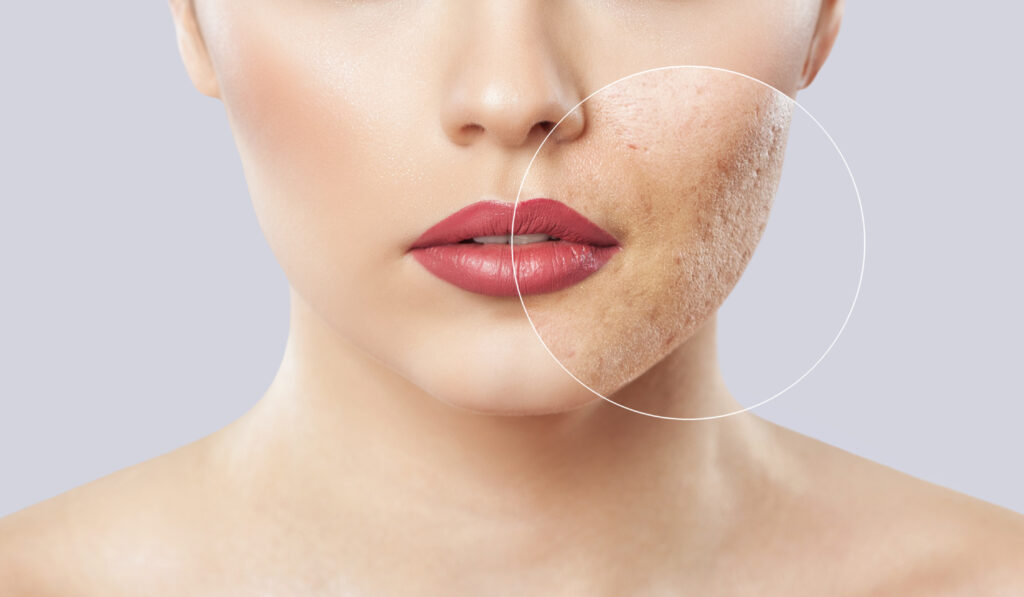Posted by: Skin And Cancer Institute in Medical Dermatology

We explored how to avoid getting acne scars in our recent blog post, “Can You Clear Acne on Your Own.” That’s where we learned that two (out of six) types of acne–nodules, and cysts–leave SCARS. We learned how to prevent acne scars by seeing a dermatologist for an oral antibiotic.
Let us mention at this point that there’s nothing wrong with acne scars if you have them. They’re a natural part of your body’s healing process. With that said, we’ve never met anyone who likes their acne scars, and most people want to know how to get rid of them.
If you’re one of these people, read on because we have all the information on the latest tech to fade your acne scars into oblivion.
How To Fade Acne Scars
The first step to getting rid of acne scars is to understand what type of scars those deep under-the-skin nodules and cysts left you.
Acne scars come in five basic shapes called boxcar, icepick, rolling, hypertrophic, and keloid. We’ll tell you what each scar looks like and then how to treat it.
Types of Acne Scars and How to Treat Them
Atrophic scars look like indentations on the skin. They include boxcar, icepick, and rolling scars.
Boxcar Scar
Looking at the shape of this scar is a bit like looking into a tiny empty box–it’s broad with sharply-defined edges.
Icepick Scars
These scars are narrow and small and go deep into the skin’s surface. They are often found on the checks. They’re tough to fade and require persistence with treatment.
Rolling Scars
This type of scar has wavy edges that make it look rolling and uneven.
There’s an arsenal of treatments for the scars mentioned above, including chemical peels, dermabrasion, dermal fillers, laser therapy, and microneedling. And there are a few treatments you probably haven’t heard of like:
- Punch excision–a cookie-cutter-like tool cuts out the scar, and the wound is stitched closed.
- Punch grafting–is like punch excision, except that it gets a plug of new skin before it’s closed.
- Subcision–uses a needle to release the tissue under the acne scar and let it rise.
- CROSS (chemical reconstruction of skin scars)–a tiny amount of acid is placed on top of the scar, which causes the formation of fresh new collagen fibers.
Hypertrophic and Keloid Scars
Hypertrophic scars look like raised bumps of scar tissue the same size as the original acne that caused them. Keloid scars, on the other hand, grow bigger than the acne that caused them. They’re also raised. Your dermatologist can reduce their appearance with techniques that include:
- Steroid injections to soften the scar and make it flatter.
- Silicone sheeting to soften the scar and reduce its height.
- Surgical removal
- Laser therapy
The Bottom Line
Deep acne nodules and cysts leave five basic shapes of acne scars. While they all are treatable, some, like icepick scars, require more persistence than others to fade.
Most atrophic acne scars (indentation) respond to treatments like chemical peels, dermabrasion, dermal fillers, laser therapy, and microneedling. They might also respond to punch excision, punch grafting, and subcision.
Hypertrophic and keloid scars are raised lumps that can respond to steroid injections, silicone sheeting, surgical removal, and laser therapy.
If you don’t like your acne scars, rest assured that our dermatologists have the expertise and technology to help make them less visible. Ready to begin your journey to smoother skin? Contact the Skin and Cancer Institute today at 888-993-3761 for an appointment.